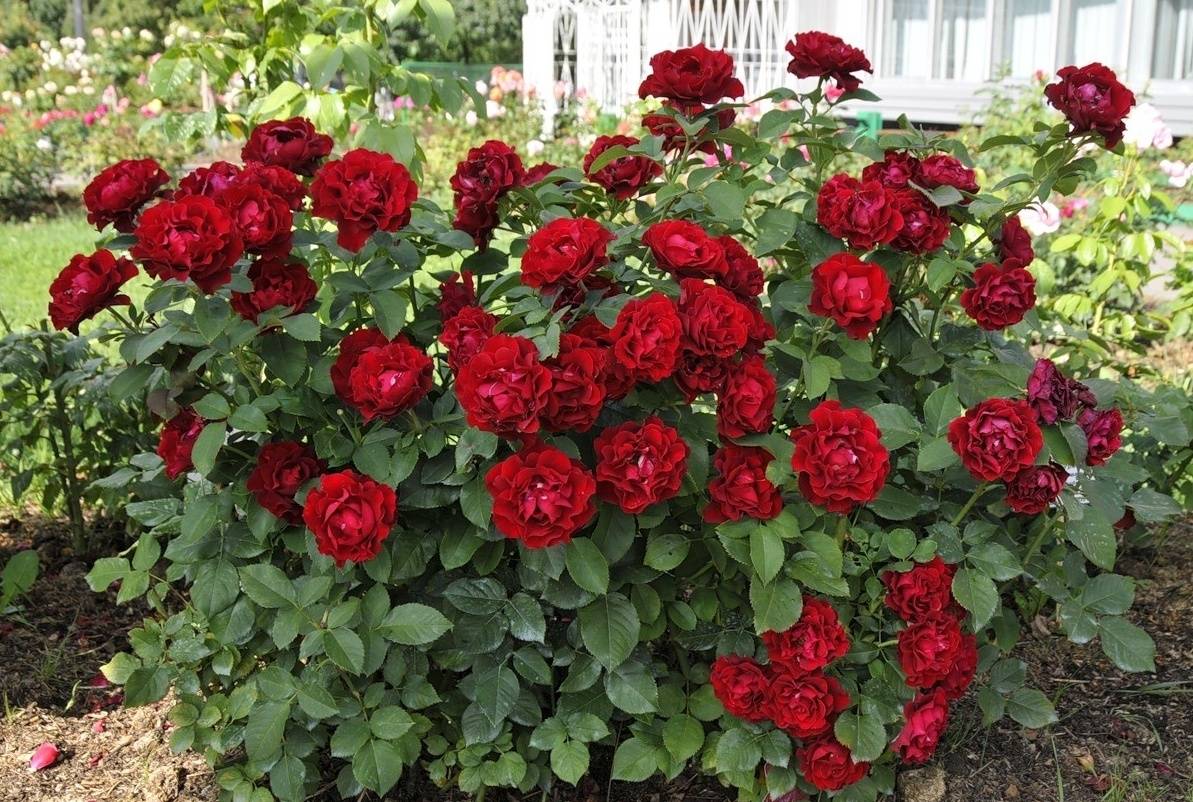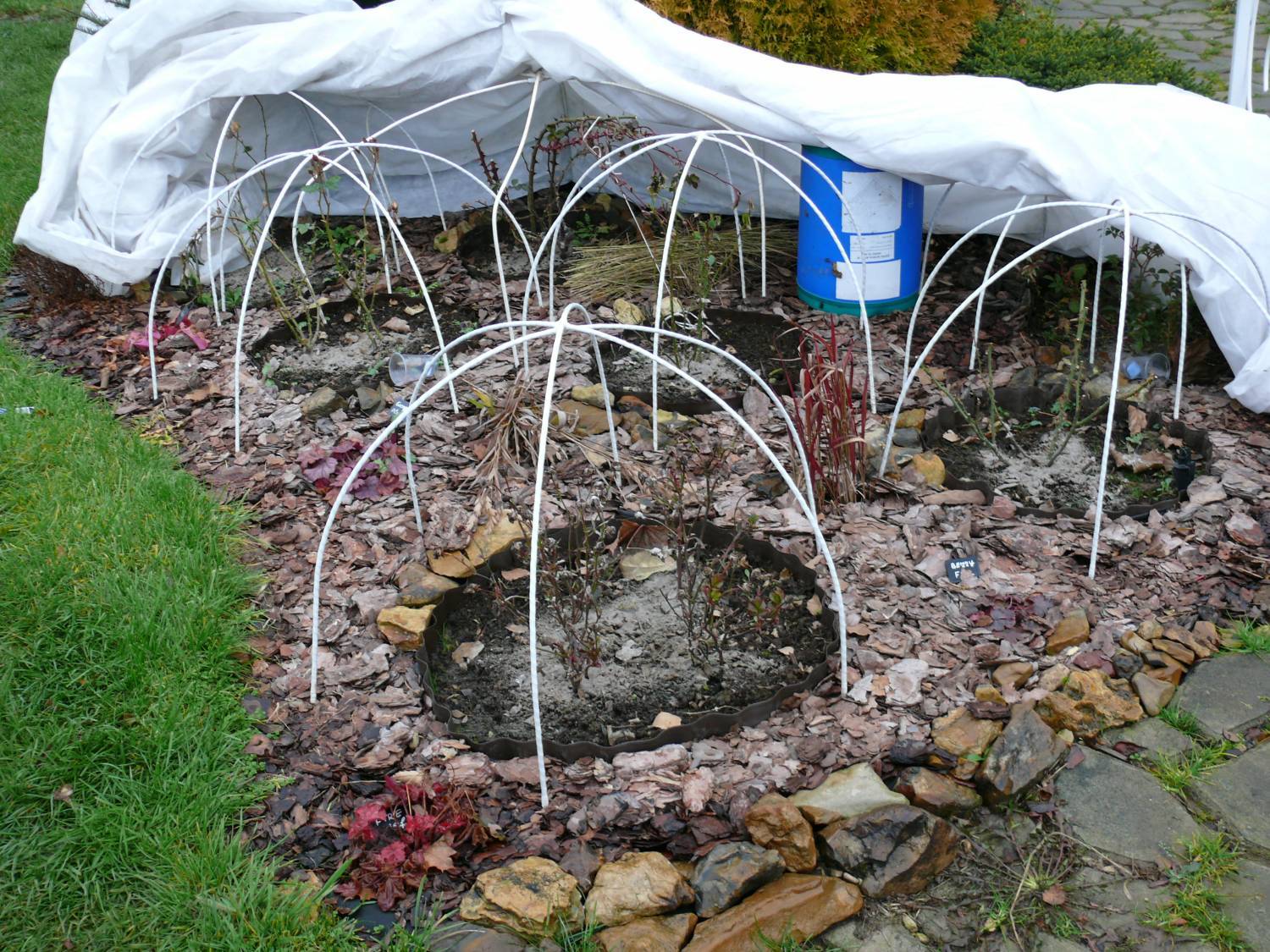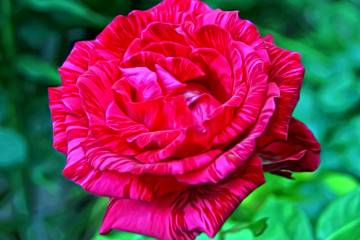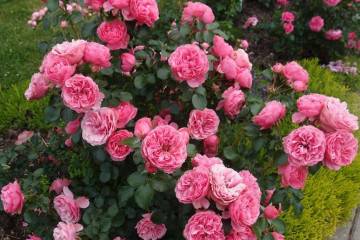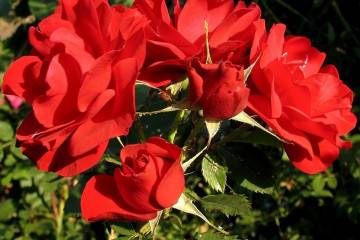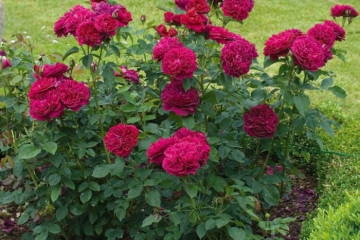Rose Omazh and Barbara (Hommage a Barbara) - variety description
Content:
A gorgeous beauty - the Omage Barbara rose was created to impress and delight. The extraordinarily beautiful flower leaves a vivid impression and is designed for high-quality cutting.
Rose Omage Barbara - what kind of variety is it, history of creation
Translated from French, Hommage a Barbara means "homage to Barbara." The variety of hybrid tea rose was bred in 2004 in the German nursery Delbard by order of the Perlimpinpin-Barbara association in honor of the popular French singer Barbara (Monique Andre Cerf).
Brief description, characteristic
Rose petals are burgundy red with a slight darkening at the edges. From the inside out in the bright sun, golden sparks are noticeable on them. The edges of the petals curve beautifully, like a drapery. The bud is very dense, even in full dissolution, stamens cannot be seen in its core.
The variety belongs to remontant, its flowering lasts from the last decade of May to the end of September. The diameter of the corollas is on average about 8-10 cm. At the ends of the shoots, clusters of 3-5 buds are formed. Less often, the shoot ends in a single bud or up to 10 flowers are collected in the brush.
On average, the height of the bushes does not exceed 80-90 cm. There are almost no thorns on the shoots. The leaves are large, dark green in color, with a glossy sheen, with jagged edges.
Advantages and disadvantages of the variety
Rosa Omage Barbara deserves high marks due to its advantages:
- Large, showy flowers with a very bright color that does not fade in the sun.
- The aroma is pleasant, but rather weak, which many consider to be a virtue.
- High resistance to rain damage.
- The rose does not fade in a bouquet for at least 7 days.
- Frost resistance up to -20 degrees.
Among the shortcomings, one can note the average resistance to powdery mildew and black spot, but in this, the rose is second only to the English varieties of David Austin.
Use in landscape design
Hommage a Barbara rose will serve as a decoration for any garden arrangement, especially in group plantings of perennials. The variety is used with equal success for borders, flower beds, planted near walls and fences. The bushes look great in free space and as part of rose gardens. Profitable rose Ommage and Barbara looks in the company of boxwood, barberry, conifers, and it will also go well with bushes with foliage of contrasting silver or red color.
Growing a flower in the open field
Planting rules for the hybrid tea rose Barbara correspond to the standard ones for this group of roses, taking into account its frost resistance (not lower than -20). Hybrid tea roses are not grown by seeds, since this method of propagation does not allow preserving varietal characteristics. If you want to grow a floribunda rose on your site Hommage a Barbara, you need to purchase seedlings in specialized nurseries.
You can plant a rose Homazh and Barbara both in autumn and spring. For an autumn planting, they choose a time when the daytime temperature averages about + 10-15 degrees, and the nighttime does not fall below +5. Spring is carried out before bud break.
Location selection
Rosa Hommaj Barbara has an extremely negative perception of stagnant water at the roots. Therefore, a site for planting is chosen at a certain elevation so that in the spring, during the melting of the snow, the water does not stagnate near the bushes.
An additional negative factor is drafts. It is best to plant a rose where on one or several sides it is protected from the winds by walls of houses, tall trees, a fence, etc. In this case, the site itself should be sunny, since it will not work to get a lush bloom in partial shade.
How to prepare the soil and flower for planting
Preparatory work begins with the planning of the landing site. If necessary, create a slight slope so that the water flows freely from the roots. Soils with a slightly acidic reaction are suitable for rose (pH = 5.0-6.0). To do this, a small amount of peat is introduced into the soil for digging. Additionally, it is useful to introduce wood ash or coal. They have a neutralizing and disinfecting effect.
Rosa Khomadzh loves loamy soil, loose, moisture-permeable. Heavy clayey and too light sandy ones will need to be pre-refined by adding a small amount of sand and humus.
Landing is carried out in the following order:
- Planting holes are dug at a distance of 45-50 cm from each other to a depth of about 40 cm.
- A thin layer of drainage is poured onto the bottom (coarse sand, screenings, expanded clay, broken brick, etc.).
- The soil in the pits is moistened 1-2 days before planting, pouring 5-10 liters of water into each.
- The seedling is lowered by its roots into the hole, keeping the position of the root collar slightly lower (3-5 cm) than the ground level.
- The filling is carried out with soil, into which humus is mixed, as well as 30-40 g of superphosphate.
- The soil around is compacted, forming a side, so that when watering, the water does not spread far from the bush.
- Water and mulch the soil.
Plant care
A not very demanding rose still needs regular watering, as well as treatments against pests and diseases. For irrigation, water is used, which is defended here on the site. In this case, its temperature is exactly the same as that of air, and harmful chlorine impurities have time to evaporate. Water consumption per 1 bush in the summer is 10 liters, the last autumn watering is 30 liters. The regularity depends on the weather, but at least once a week.
During the season, the rose must be fed at least 4 times: after the dissolution of the buds, before forcing the first buds, in the middle of summer and before frost for 2-3 weeks. In the spring, nitrogen fertilizers are applied, and the rest of the time, potassium-phosphate fertilizers, alternating with organic ones (mullein, humate).
Pruning and replanting
Like other floribunda varieties, Ommaj a Barbara requires sanitary, shaping and rejuvenating pruning. In the first year, only 3-4 buds should be left on the branches of the 1-2 order. In the 2nd year, all branches of the 2nd order are shortened by a third, and the 3rd order is cut out completely. Before wintering, the crown is shortened by half.
The bushes are transplanted in the spring before the buds dissolve or in the first decade of September. Before this, the shoots are cut so that the height of the bush does not exceed 50 cm. In the fall, all the buds are cut off.
Features of wintering a flower
For the winter, the bushes are covered if the temperature in the region in winter drops below -10 degrees. A frame made of wire or slats, arcs is installed on top of the bush. Burlap, agrotextile are pulled over, or spruce branches are thrown over. You can use cardboard boxes as cover, crushing them from being blown away by the wind stones. Shelters are removed when the soil has completely thawed in the spring.
Blooming rose
If the plant is healthy, receives enough sunlight and fertilizers, does not suffer from drought, then its beautiful flowering continues all summer. The first buds on Barbara appear at the end of May. Further forcing takes place almost continuously until September.
While the bush is blooming, it is necessary to regularly cut off the faded buds, which take up nutrients before falling off. To enhance the splendor of flowering, top dressing is used with a mullein solution (1 liter per 10 liters of water). Such organic food alternates with mineral food. For example, potassium sulfate is used (30 g per 10 l of water) or calcium nitrate (1 tbsp. L. Per 10 l of water).
What to do if it does not bloom
A lack of flowers on a rose is a symptom of a lack of nutrition and / or light. If buds do not appear when feeding is resumed, the bush should be dug up and transplanted to a more sunny area. Sometimes the rose stops blooming due to a too thickened crown, then you will need to carry out anti-aging pruning.
Flower propagation
Hybrid tea varieties are not propagated by seeds, only the cuttings method is suitable.
The optimal time for cutting cuttings is the first half of summer. Young bushes will need at least 1.5-2 months for rooting. Cuttings are cut from annual shoots 0.5-0.7 cm thick with slightly lignified bark. The length of the cutting is 10-15 cm, it should have 2-3 buds. The leaves are cut off from below and above, and the remaining ones are shortened. The stalk is planted in the soil and covered with a cut plastic bottle on top. It is not removed for 2 months. The garden bed with cuttings is regularly watered, and successfully rooted specimens are transplanted to a new place only in the next May.
Diseases, pests and ways to control them
The greatest damage to roses of hybrid tea varieties is caused by powdery mildew, rust, black spotting. In the spring, even before the buds dissolve, it is recommended to spray all the bushes on the site with Bordeaux liquid. After that, at weekly intervals, 2-3 treatments are carried out with the fungicides "Topaz", "Strobi", etc. Against aphids, rosefly sawfly and other pests are treated with preparations of prolonged action "Iskra Zolotaya", "Confidor Extra", etc.
The valuable advantage of the Barbara hybrid tea rose is its very long flowering period. All summer long, her flowers can be cut for home decoration and as a gift to friends. Standard care, ease of reproduction, great appearance of the bushes - everyone will find for themselves something to fall in love with this French variety.
